ScandiVanadium‘s recently issued ASX Announcements, one dating November 14, 2019 and another dating November 29, 2019, are interesting reading. These announcements detail some of the analytical results of drill holes HDD001, HDD001B, HDD002, HDD003B, and HDD005 from Lybymosse.
During the drilling campaign, ScandiVanadium used a hand-held X-ray fluorescence (XRF) instrument to directly measure the vanadium content of the drilled rocks. Such instruments are frequently used in the field to obtain a first idea of the type and amount of certain (measurable) elements present in a sediment or rock. As such these field analyses allow delimiting zones of interest, and as was the case in Lybymosse, helped identifying the intervals where samples for further analyses needed to be taken.
Once these zones had been determined by initial XRF analysis, ScandiVanadium took continuous rock samples from the drill cores along the designated intervals and sent the samples to the ALS Laboratory in Piteå for Inductively Coupled Plasma (ICP) analysis. These latter analyses, which are now ready and presented in the two ASX Announcements, allow a better characterization of the various elements in the rock samples, and provide more exact values for, for example, how much vanadium is present in the Lybymosse Alum shale.
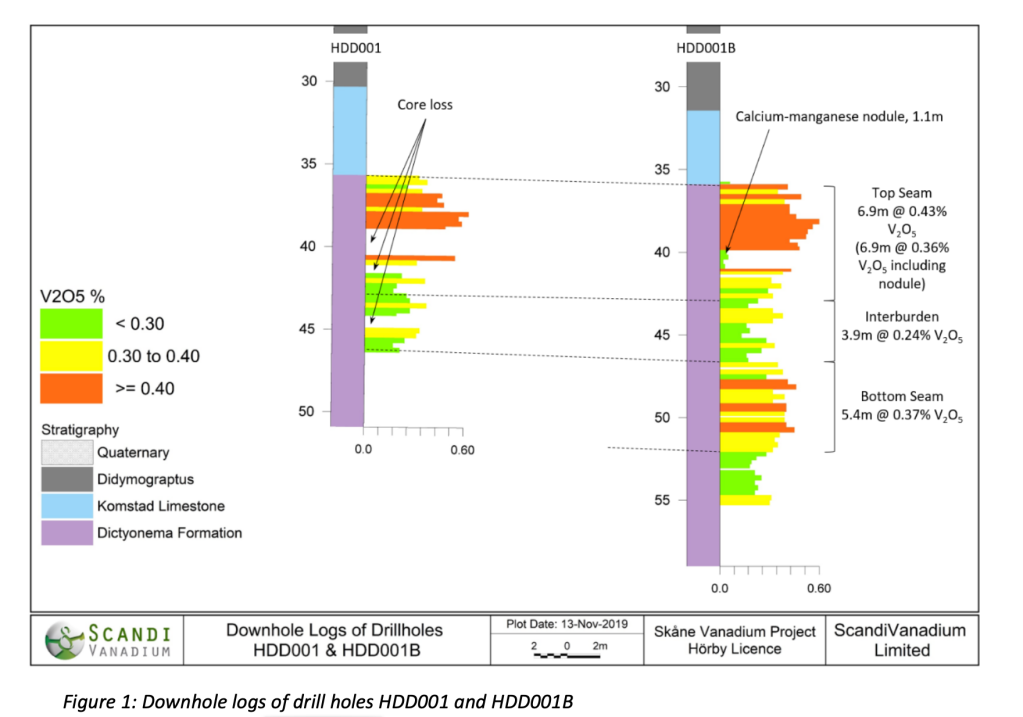
To illustrate the different rock units encountered in Lyby, ScandiVanadium presents a very simplified stratigraphy (vertical columns in the figures above and below). The Stratigraphy shown by ScandiVanadium makes reference to an old and outdated geological terminology, such as “Didymograptus” and “Dictyonema Formation”. I have discussed earlier that the term ‘Dictyonema shale’ is no longer used in more recent work. The same holds true for Didymograptus, as stated by Eriksson (2012): “The formation name Almelund Shale was recently adopted by Bergström et al. (2002) instead of the outdated topostratigraphical designations Upper Didymograptus Shale and Lower Dicellograptus Shale” (Eriksson 2012, p. 18). Accordingly, in Eriksson’s (2012) Figure 5, which is shown below, these old names are abandoned and referred to as ‘traditional names’. Terms such as ‘Dictyonema Shale’, are thus pretty much off and do not exist anymore in the current literature. Moreover, using the term ‘Dictyonema Formation’ as is done by ScandiVanadium is not compatible with current geological terminology, as can be seen in Eriksson’s (2012) figure below.
I am aware that these differences may sound like hair-splitting to non-specialists. But they are nevertheless important in the current context. By calling the Alum shale for ‘Dictyonema shale’ or ‘Dictyonema Formation’, as done by ScandiVanadium, one can get the impression that we are dealing with a rock type that has nothing to do with an Alum shale; just using the term ‘Dictyonema shale’ implies that this rock type is completely different from the Alum shale, and as such does not have the same properties as an Alum shale. But this is not correct.
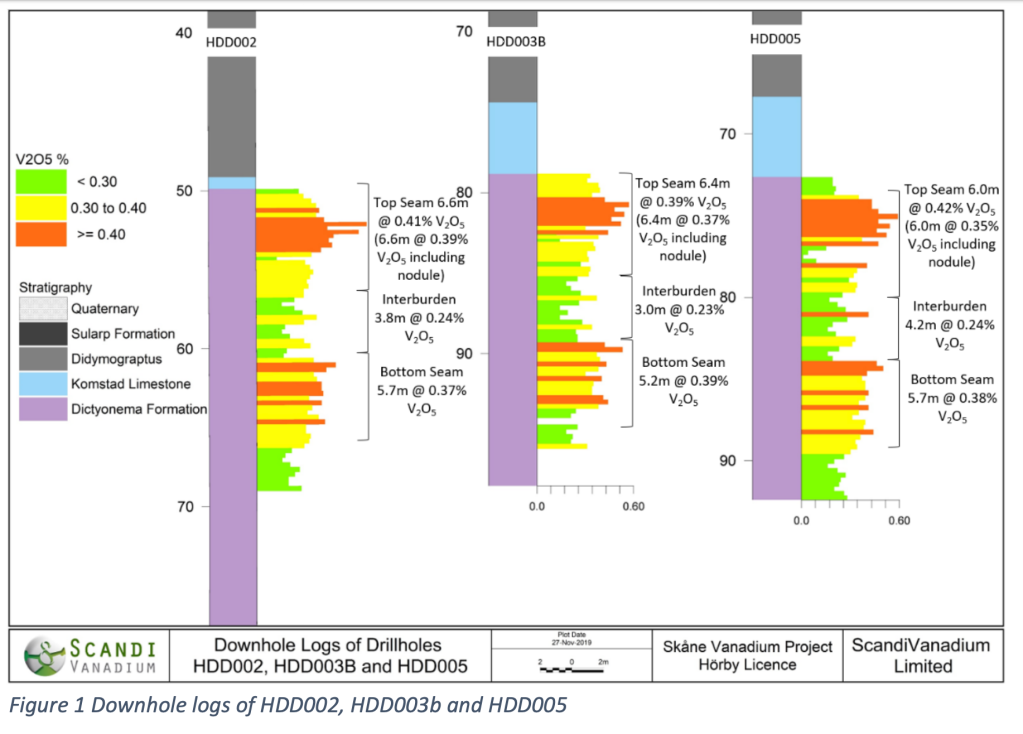
Following Eriksson’s (2012) work (see Figure below), ScandiVanadium‘s Lybymosse core stratigraphy could probably be translated into the following: Alum Shale Formation (purple color), Björkåsholmen Formation and Toyen Shale (likely missing in the Lyby cores), Komstad Limestone (blue color) and Almelund Shale (grey color). What we can conclude from looking at ScandiVanadium‘s simplified stratigraphies is that the Alum shale (purple color) is directly overlain by Komstad Limestone (blue color) and that rock layers belonging to the Björkåsholmen Formation and the Toyen Shale are missing.
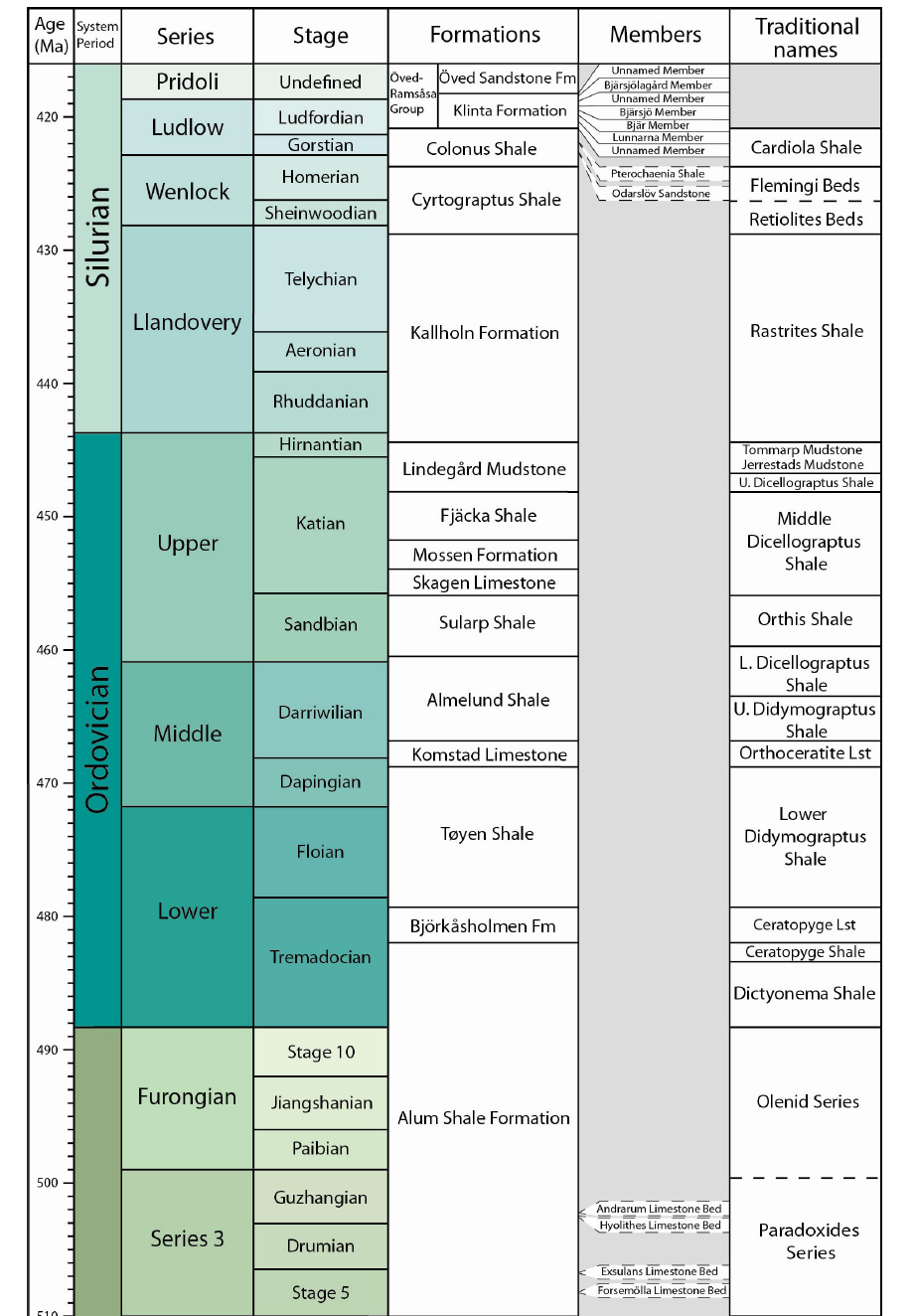
But now back to what the new analyses show. Obviously, as can be seen in ScandiVanadium‘s figures below, the analyzed cores show a distinct interval with values of >40 % vanadium pentoxide (red colored horizontal bars) in the uppermost part of the Alum shale (purple color and termed Dictyonema Formation). Yellow and green horizontal bars indicate intervals, where vanadium pentoxide values are 0.30-0.40 % and <0.30%, respectively. The exact values for vanadium pentoxide for the different cores are detailed on pages 6-7 (November 14, 2019) and pages 6-8 (November 29, 2019) in ScandiVanadium‘s ASX Announcement.
A look at the analytical results for hole HDD001 shows that only one of the red bar values for vanadium pentoxide attains 0.62%. The remaining seven ‘red’ horizontal bars correspond to values of between 0.43 and 0.58% vanadium pentoxide. Values shown in yellow color range between 0.31 and 0.37% vanadium pentoxide. For hole HDD001B the situation is not much different. One single sample gave a vanadium pentoxide content of 0.60%, whereas all the other samples shown by red horizonal bars only gave between 0.40 and 0.56 % vanadium pentoxide.
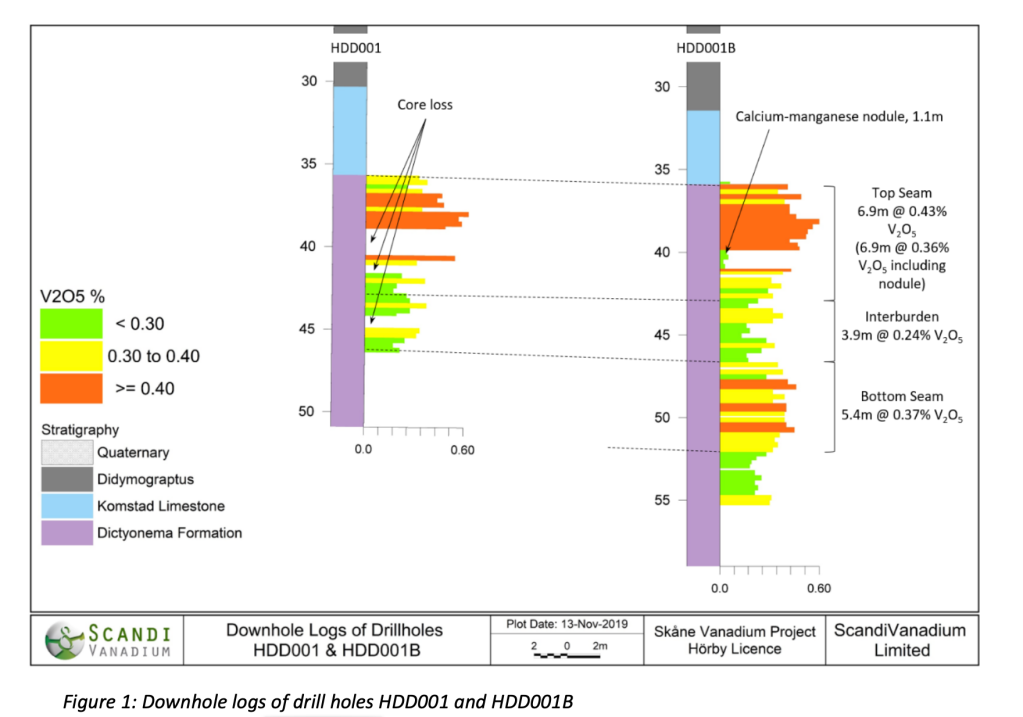
What about hole HDD002 then? For this drill core, only two samples provided a vanadium pentoxide content of 0.70% and 0.65%, respectively, while the other values in the red interval are between 0.40 and 0.50%. In hole HDD003b the highest value is 0.57% vanadium pentoxide for one single sample and values range between 0.40 and 0.54% vanadium pentoxide for the remaining samples shown in red color. And finally, in hole HDD005 only one sample provided 0.59% vanadium pentoxide, all other ‘red bar’ samples have values of between 0.41 and 0.54% vanadium pentoxide.
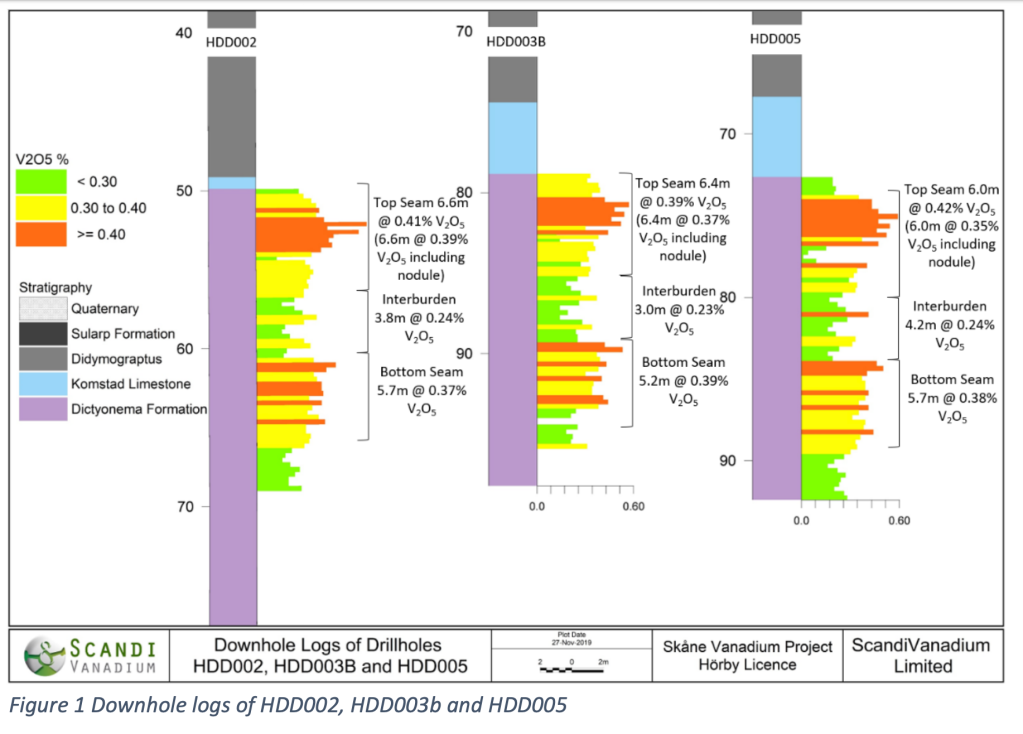
How do these values compare to what ScandiVanadium states on their webpage? “The project shows potential to develop a large, long life vanadium operation; with an exploration target of 610Mt – 1,200Mt @ 0.5-0.8% V2O5 (Vanadium pentoxide) in a sediment hosted black-shale ore deposit which dips gently from surface“. The results obtained on the Lyby cores do not match this statement.
None of the analyzed samples provided values of 0.8% vanadium pentoxide. Only very few samples in the five analyzed cores gave values equal to or above 0.50% vanadium pentoxide. To be exact, values equal to or above 0.50% vanadium pentoxide have been measured on 4 samples in HDD001, on 4 samples in HDD001B, on 3 samples in HDD002, on 4 samples in HDD003B and on 4 samples in HDD005. In short, these values are far from what ScandiVanadium and probably also their shareholders had expected.
But maybe ScandiVanadium is nevertheless happy with the results and will further pursue the Lybymosse mine project?
I think it would be an interesting exercise to calculate how much Alum shale will have to be dug out and processed in order to obtain economically acceptable vanadium pentoxide quantities. My guess is that one will need huge amounts of Alum shale. And all of the processed shale containing other toxic elements will of course needed to be deposited and redeposited.
References cited:
Eriksson, M. (2012): Stratigraphy, facies and depositional history of the Colonus Shale Trough, Skåne, southern Sweden. Master’s thesis, no 310.


Pingback: Charming the media? | Barbara Wohlfarth